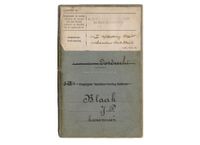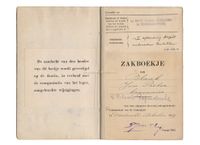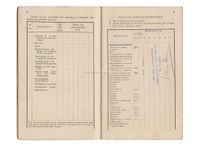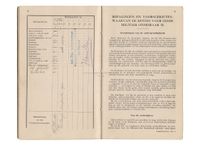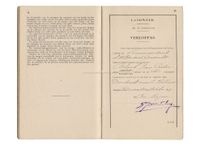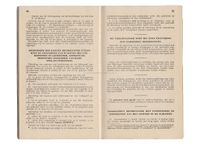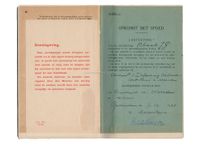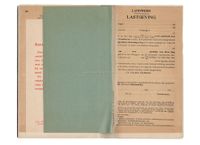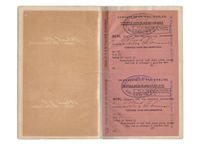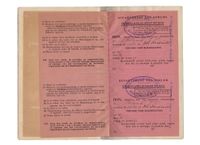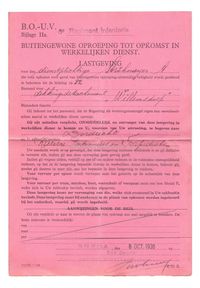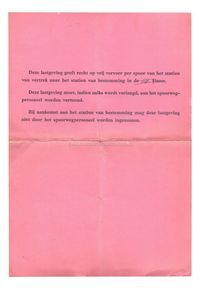Military and Mobilization.
On this page, all military documents related to the surroundings of Dordrecht will be posted. A separate page has been created for the Korps Pontonniers en Torpedisten. ( Army Maritime Engineers Depot ) You can find it here: Army Maritime Engineers Depot.
Leave Pass Conscripted Soldier C.J.J. Kraayenbrink.
Below you will find the Leave Pass of Conscripted Soldier C.J.J. Kraayenbrink from Dordrecht. Dpl. Soldier Kraayenbrink went on Great Leave on June 11, 1940. He belonged to a late batch, namely that of 1940, and was still serving in the 4th depot company of the 6th depot battalion. It is likely that he had not been called into active service in May 1940. Unfortunately, I do not have the soldier's date of birth, so it is currently not possible to obtain further information about his military service history.
Leave Pass Wachtmeester J.v.d. Bosch.
Below you will find the Leave Pass of Wachtmeester J.v.d. Bosch, assigned to the staff of the 2nd battalion of the 28th infantry regiment. Wachtmeester v.d. Bosch went on Great Leave on May 25, 1940. The document is signed by Second Lieutenant A.K.R. de Lange. Sergeant v.d. Bosch may have been present during the ambush of the Ravelli battalion. Units of the 2nd battalion, including the staff, were part of that battalion in May 1940. The ambush by German paratroopers caused significant losses to the unit, and a large number of Dutch soldiers were captured during this action. Later, the commander, Major Ravelli, was also captured by German paratroopers. Second Lieutenant de Lange was present during this action and was also captured.
Roll Call Booklet Sergeant M.D.J. Robart.
Below you will find photos of the roll call booklet of Sergeant M.D.J. Robart. Marinus Dirk Jan Robart was born on February 13, 1912. He was a clerk by profession. On June 20, 1932, he was called up as a conscript in the 3rd Infantry Regiment. He went on various exercises and had several periods of Great Leave. He returned from Great Leave on August 25, 1939. During May 1940, he was under arms with the 3rd Infantry Regiment. After May 1940, he went on Great Leave again on July 14, 1940. After that, he worked in the 2nd Department of the 62nd Corps Reconstruction Service. The Reconstruction Service ( Opbouwdienst ) was intended as employment for Dutch soldiers who were unemployed. They were mainly involved in removing defensive works and clearing war damage. The roll call booklet likely contains the names and addresses of soldiers from this corps.
Dutch military topographic maps.
Below you will find the Dutch equivalent of topographic maps. Dordrecht is divided into two maps here. These are Dutch topographic maps from the mobilization period.
Artillery Firing Orders - Dutch artillery, May 1940.
Below you will find some handwritten firing orders from May 1940. The orders were written by Reserve Captain H.B. Frijlink of the artillery group staff of Artillery Command Group Kil. The 23rd Artillery Regiment's units were equipped with 7-Veld cannons. I-23 R.A. had three batteries, each with four guns. The unit was stationed north of Mookhoek and under the command of Major F.H.H.M. Bensel. II-23 R.A. had two batteries, also with four guns each. The unit was under the command of Major D. Das and was stationed east of Strijen. The 25th Artillery Department ( 25 AA ) was under the command of Reserve Captain E. Cohen. This unit was equipped with 12 outdated 15 lang staal cannons and was positioned along the southeast bank of the Dordtse Kil in the Hoekse Waard. Both artillery units were part of Group Kil.
During the May days, these artillery units regularly fired at Moerdijk, Willemsdorp, and even Dordrecht. *1 The first firing order dates back to May 10, 1940 - 6:15 AM. I-23 R.A. and II-23 R.A. were ordered in this firing order to fire with one battery at German paratroopers within the Moerdijk bridgehead. The second firing order is directed to the commander of I-23 R.A. with the instruction to fire at the northern exit of Willemsdorp. The next firing order is directed to the commander of 25AA with a firing order on previously given coordinates. The following firing order is once again directed to the commander of II-23 R.A., with the instruction to fire at the bend in the Streeplandsche weg and then at the intersection near Lage Zwaluwe station. It is then mentioned that I-23 R.A. is firing on friendly infantry and should adjust its fire forward by 200 meters. The final note is from after the surrender. Blankets are to be delivered to a German non-commissioned officer at the office of I-23 R.A.
Documents of Landstorm conscript B de Visser.
Below you will find a collection of documents belonging to Dordrecht resident Barend De Visser. Barend, born on June 9, 1891, worked as a plasterer and lived at Vleeschouwerstraat 21/23 in Dordrecht. On May 17, 1916, he was called up for military service in the Landstorm ( Army Reserve ) as part of the 1911 conscription class. His actual induction took place on Tuesday, July 11, 1916, in Woerden. He was then assigned to the 2nd depot company of the 3rd Regiment Vesting-Artillerie. ( Fortress Artillery ) Barend was one of the thousands of conscripts called upon to safeguard the neutrality of the Netherlands when World War I was raging in Europe. The collection includes Barend's songbook, as well as his pocketbook and field pocketbook. Additionally, there is a poster for the Preparatory Training Institute of the Volunteer Landstorm, addressed to A.L. de Visser and dated 1933. This may be directed to Barend's son. The collection also includes ration coupons and two distribution identity cards belonging to Mrs. Antonia Paulina de Zeeuw.
Documents of Mr. J. Romijnsen.
Below you will find the extensive set of military documents belonging to Mr. J. Romijnsen from Dordrecht. Along with his military documents, there are also documents related to his work at the Victoria Factory. On this page, you will find the military documents.
Johannes Romijnsen was born on August 18, 1917, in Dordrecht. He was working at the Victoria Koekjesfabriek
( cookie factory ) when he received a call-up from the mayor of Dordrecht on November 3, 1937, to report for military service on December 21, 1937. Johannes was then assigned to the 2nd Regiment of Field Artillery, where he was discharged after a little over a year due to deficiencies. The exact nature of these deficiencies remains unclear, but his military service was terminated due to health reasons. He spent some time at the sanatorium in Renkum. On April 8, 1939, he was discharged from the army barracks at Oldebroek by the commander of the 2nd Regiment of Field Artillery. Following this, Johannes returned to Dordrecht and resumed working at the Victoria Koekjesfabriek. Various documents confirm this, including a letter from a German Hauptmann stating that Johannes is performing important work at the cookie factory. At some point, he got married to Johanna Engels, as indicated in a Red Cross letter dated May 24, 1945, when Johannes writes to his wife J. Romijnsen-Engels from Winterswijk. The reason for the Red Cross letter and his stay in Winterswijk is unknown. Perhaps Johannes was forced to work as a laborer by the Germans.
Johannes's military documents consist of a call-up for military service by the mayor, an envelope from the 2nd Regiment of Field Artillery, two letters from the military hospital addressed to Johannes's father, a letter from the medical officer, two discharge certificates, an order to return state property, and a receipt for the return of state property.
ou will find the civilian documents of Mr. Romijnsen here: Other Documents.
The military documents of Mr. Romijnsen can be found below:
Documents marine Sliedrecht.
Below you can find two documents related to the pre-war service of a marine from Sliedrecht. The first document is a letter from January 1938 inviting Mr. C.T.B. de Visser from Sliedrecht for the initial medical examination. The letter was sent the Central Bureau for the Recruitment of Naval Personnel. It appears that the individual in question had a short training period with the Marine Corps, as an honorable discharge upon request followed in September 1938 after the probationary period of three months. The last document is signed by Lieutenant Colonel F. Lugt, who was also the commanding officer of the Marine Corps training during May 1940.
Programs of the Military Recreation Committee.
Below you will find 21 programs organized by the Military Recreation Committee. During the mobilization period, hundreds of Dutch soldiers were stationed on the island of Dordrecht. In order to keep these soldiers, who often spent a long time away from home, occupied and provide some distraction from the daily military routine, regular activities were organized. These activities were primarily organized by the Military Recreation Committee and facilitated by various parties such as:
- Employee Association of the Dordrecht Council of Labour.
- Orchestral Association Sonorita.
- The Dordrechtsche Riding Society in the Manege at the Vest.
- The Victoria Biscuit and Chocolate factory.
- Central Alcohol Control Committee.
- Amusement Club O.K.
- Dordrecht Harmonica Orchestra Association Crescendo.
- Theater Group of the Royal Association of Former Non-Commissioned Officers, Dordrecht Division.
- Fanfare Army Maritime Engineers Depot
- Dordrecht Firefighters Association.
And others.
The evenings were organized at various locations, such as the military home Benvenuta, also known as Villa "Maria," located on the corner of the Singel and Johan de Wittstraat. Other evenings were held at the Patrimonium building on the Lange Breestraat 24. Yet, other events took place at the "Americain" building on Groenmarkt. The documents, which also served as entrance tickets, have been exceptionally well-preserved and provide an interesting glimpse into the mobilization period in Dordrecht. The documents are dated from November 1939 to April 1940. The regional archive of Dordrecht's image bank contains several photos of some of the parties and locations that facilitated the relaxation evenings for the military. *2
*2 regional archive of Dordrecht's image bank:
Orchestvereniging Sonorita. Dordrechtse rijsociëteit. Militair tehuis Benvenuta.
Centraal drankweer comité. Crescendo. Gebouw Patromonium.
Bond oud-onderofficieren Dordrecht. Dordrechtse Brandweervereniging. Gebouw Americain.
Pocketbook ( paybook ) Mr. Jan Pieter Blaak.
Below you will find the pocketbook of Mr. Jan Pieter Blaak. Mr. Blaak was born on November 3rd, 1893 in Papendrecht and worked as an ironworker. His parents were Dirk Blaak and Maria van der Zijde, and he had one older brother Cornelis Blaak, who passed away at the age of three, nearly two years later. He also had a younger sister: Tuitje Cornelia Blaak, born in 1897. Jan Pieter Blaak was enlisted for military service on March 5th, 1913, as part of the conscription of the 19/3 batch from the municipality of Papendrecht. He was assigned to the 3rd regiment fortress artillery. On May 2nd, 1913, he was transferred to the 1st regiment fortress artillery. He went on furlough on November 15th, 1913. On August 1st, 1914, he returned due to mobilization. Meanwhile, on September 11th, 1918, he got married to his bride: Maria Celestina Amelberga de Wolf in Dordrecht. He was still mobilized at that time. On August 1st, 1919, he moved from the 3rd company, 4th battery of the 1st regiment fortress artillery to the 3-IV-1 Landweer Afdeling ( army reserves department )of the Landweer District Dordrecht as a gunner. On October 1st, 1919, he went on furlough again as part of the demobilization. By reorganization, on September 1st, 1922, he was transferred to the regiment fortress artillery. On December 15th, 1927, he was transferred again to the 1st regiment dismounted artillery and became part of the supplementary reserve. At the back of his pocketbook, there are some travel vouchers of model C, which he could use to travel to his mobilization destination in Woerden if necessary. The vouchers are stamped by the mobilization office of the regiment fortress artillery. The vouchers were never used. As of April 1st, 1933, Jan Pieter Blaak was again transferred due to reorganization, this time to the 1st regiment field artillery. Despite being over 100 years old, the pocketbook is still in excellent condition. It provides us with an interesting insight into the military career of a conscript from over 100 years ago.
B.O.U.V. Document A. Ströhmeyer.
Below you will find the B.O.U.V. (Extraordinary Call-up for External Security) document of Adrianus Ströhmeyer. It was a document by which conscript soldier Ströhmeyer was mobilized for the purpose of the Dekkingsdetachement Willemsdorp ( Willemsdorp Covering Detachment.) The document dates back to October 8th, 1938, which undoubtedly had to do with the German annexation of the Sudetenland. The B.O.U.V. was a pre-mobilization measure aimed at securing and guarding key strategic objects and border areas. Prior to the General Mobilization in August 1939, there were several such B.O.U.V.'s in the Netherlands.
©2017-2024 :Https://www.Dordrechtindeoorlog.nl: ( There is a copyright on the content of this website. This content is not to be shared, duplicated or published withouth the explicit permission of the author of this website. If you have any requests you can email to: Info@Dordrechtindeoorlog.nl or look on : www.dordrechtindeoorlog.nl/termsofuseforthecontentonthiswebsite.
*1 Source: Zuidfront-Holland1940 - Hoekse Waard.
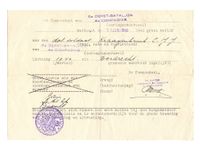
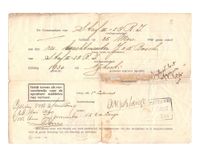


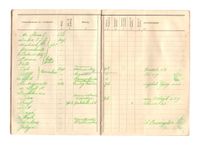


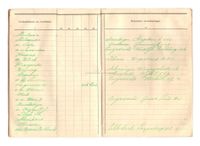


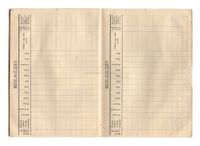

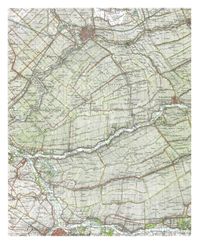
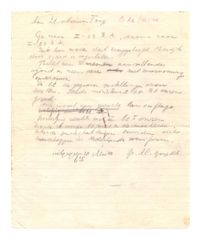
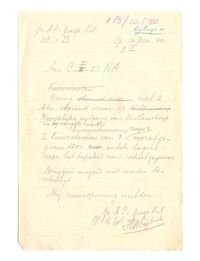
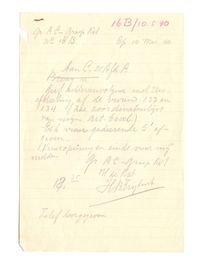

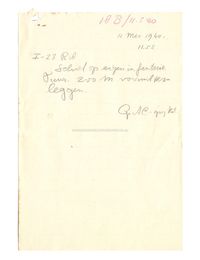

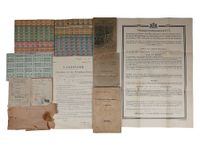

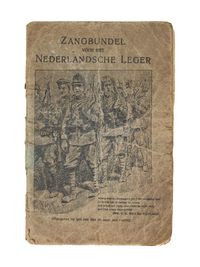
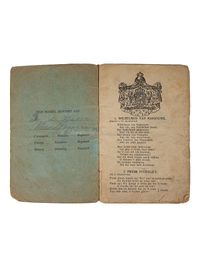
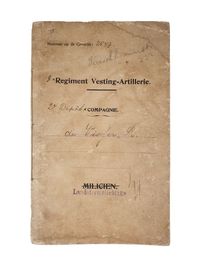
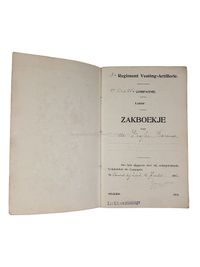
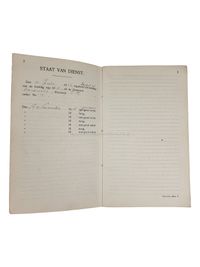
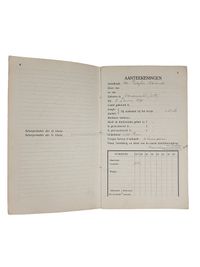


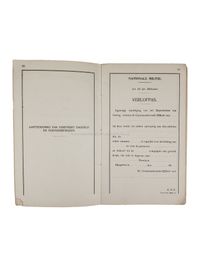
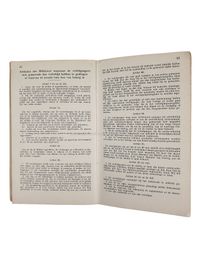

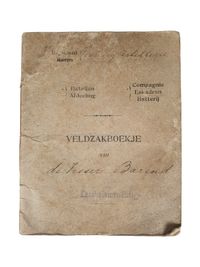

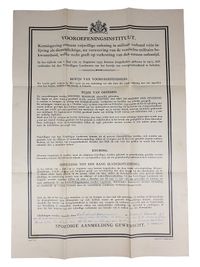

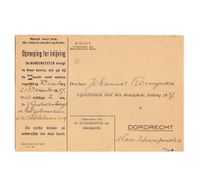

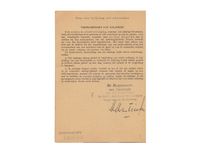
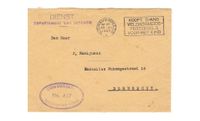
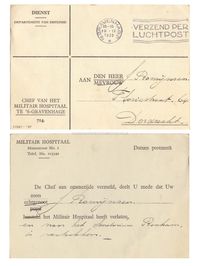

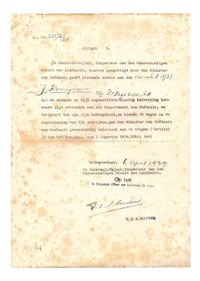
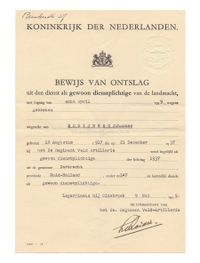
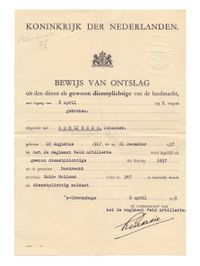
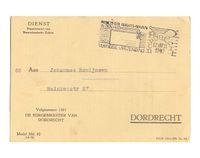

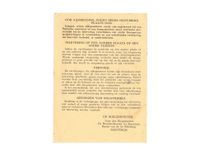

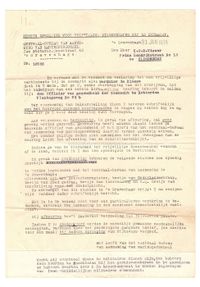

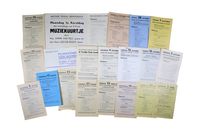

.jpg/picture-200?_=181beac5509)
.jpg/picture-200?_=181beac52a4)
.jpg/picture-200?_=181beac502a)
.jpg/picture-200?_=181beac4dc0)
.jpg/picture-200?_=181beac4b69)
.jpg/picture-200?_=181beac4910)
.jpg/picture-200?_=181beac46b5)
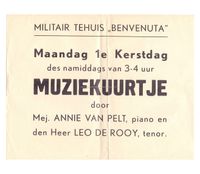
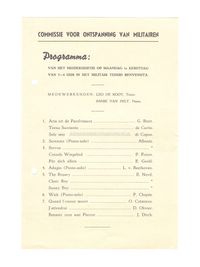
.jpg/picture-200?_=181beac3e73)
.jpg/picture-200?_=181beac3c06)
.jpg/picture-200?_=181beac39a1)
.jpg/picture-200?_=181beac3734)
.jpg/picture-200?_=181beac34bc)
